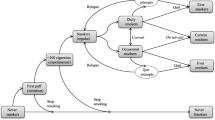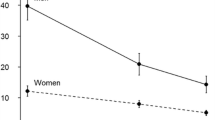Abstract
In order to establish the effective strategies to reduce the smoking prevalence among teenagers in Japan, the author evaluated opinions of the 30 male medical students with smoking habit by the Analytic Hierarchy Process (AHP) method. In the AHP model, the six factors are considered to be important for the onset of teenagers smoking; smoking habit of peers, smoking habit of family members, tobacco advertising, convenience to buy cigarettes, social acceptance of smoking and knowledge of harmful effects of smoking, and the five strategies are proposed; tobacco advertising ban, higher pricing of tobacco, promotion of antismoking education, regulation on tobacco sales, and regulation on smoking area. According to the medical students’ perspective, the strategy of “higher pricing of tobacco” was considered to be the most effective strategy to reduce the smoking incidence of the teenagers, followed by “regulation on tobacco sales”, “promotion of anti-smoking education”, “regulation on smoking area”, and “tobacco advertising ban”
Similar content being viewed by others
References
U.S. Department of Health and Human Services. A Preventing Tobacco Use among Young People. A Report of the Surgeon General. Atlanta, Georgia: U.S. Department of Health and Human Services, Public Health Service, Center for Disease Control and Prevention, National Center for Chronic Disease Control and Health Promotion, Office on Smoking and Health, 1994.
Glynn TJ, Greenwald P, Mills SM, Manley MW. Youth tobacco use in the United States-problem, progress, goals, and potential solutions. Prev Med 1993;22: 568–75.
Ministry of Health and Welfare Kosei Hakusho (Annual Report of Health and Welfare) Tokyo Gyousei 1997 74–9. (in Japanese)
Center for Disease Control and National Cancer Institute. Adult use of tobacco-1975, Washington, D.C., U.S.Department of Health, Education, and Welfare, 1976.
Saaty TL, Vargas LG. Prediction, Projection, and Forecasting. Massachusetts: Kluwer Academic, 1991.
La Greca AM, Fisher Jr EB. Adolescent smoking. Pediatr Ann 1992;21:241–8.
Wang MQ, Fitzhugh EC, Westerfield RC, Eddy JM. Family and peer influences on smoking behavior among American adolescents: an age trend. J Adolesc Health 1995;16: 200–3.
Adrados JL. The influence of family, school, and peers on adolescent drug misuse. Int J Addict 1995;30: 1407–23.
Grossman M. Health benefits of increase in alcohol and cigarette taxes: Br J Addict 1989;84: 1193–204.
Chunichi, Shinbun, 25 August 1993; Sunday version 1, 8. (in Japanese)
Perry CL, Kelder SH, Murray DM, Klepp KI. Communitywide smoking prevention: long-term outcomes of the Minnesota Heart Health Program and the Class of 1989 Study. Am J Public Health 1992:82:1210–6.
Elder JP, Wildey M, de Moor C, Sallis Jr JF, Eckhardt L, Edwards C, et al. The long-term prevention of tobacco use among junior high school students: classroom and telephone interventions. Am J Public Health 1993;83: 1239–44.
Resnicow K, Cross D, Wynder E. The know your body program: a review of evaluation studies. Bull N Y Acad Med 1993;70: 188–207.
Bishop JA, Yoo JH. “Health scare,” excise taxes and advertising ban in the cigarette demand and supply. Southern Economic Journal 1985;52:402–11.
Rimpela MK, Aaro LE, Rimpela AH. The effects of tobacco sales promotion on initiation of smoking—experiences from Finland and Norway. Scand J Soc Med (Suppl) 1993;49; 5–23.
Muramatsu T, Nomura K, Kitai M, Kataoka S, Ogawa H, Muramatsu S, et al. A study on the image, knowledge, attitude and behavior towards smoking among high school students Part 1). Jpn J School Health 1994;36: 339–49. (in Japanese with English abstract)
Muramatsu T, Nomura K, Kitai M, Muramatsu S, Akita T, Ogawa H, et al. A study on the image of smoking among junior high school students by watching TV-tobacco commercials. Jpn J School Health 1994;36: 487–95. (in Japanese with English abstract)
Author information
Authors and Affiliations
Corresponding author
Rights and permissions
About this article
Cite this article
Matsuda, S., Washino, K. How do the Japanese medical students evaluate the effectiveness of anti-smoking strategies?- an application of the Analytic Hierarchy Process. Environ Health Prev Med 3, 73–77 (1998). https://doi.org/10.1007/BF02931787
Received:
Accepted:
Issue Date:
DOI: https://doi.org/10.1007/BF02931787




